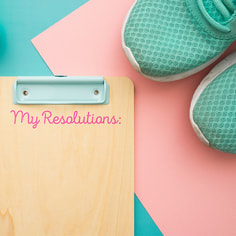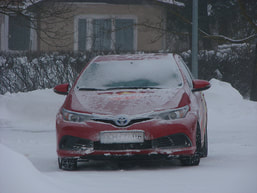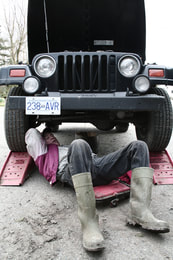|
Now that we are in the thick of summer’s high temperatures, the heat can take a toll on everyone—including your car. Extreme heat can push a car past its limits, which could lead to some drivers stranded along the roadside. The following tips from RK Collision Repair Center can help you avoid becoming one of those drivers—plus a bonus section for what to do if your car overheats.
Check your battery. Issues with batteries do not always happen in the winter months. In fact, the summer heat can have more of a negative impact on your battery life than the cold temperatures. Ensure your battery is securely mounted to avoid excessive vibration when driving, clean any corrosive build-up from the battery terminals, and if the battery is more than three years old, have it tested to determine how much longer it will last. Check and keep your tires properly inflated. Driving on tires that are under-inflated can cause tires to overheat, which increases the likelihood of a blowout—particularly when temperatures are extremely high. It is recommended to check the tire pressure (including in your spare tire) at least once a month. Ensure fluids are at recommended levels. When fluid levels are low, the opportunity for overheating is increased. Check oil, transmission fluid, brake fluid, and power-steering fluid, and ensure their levels are according to the recommended specifications for your vehicle. Keep your engine cool. Your vehicle has a cooling system that is intended to protect the engine from overheating. Ensure the coolant is filled to the proper level by checking the overflow reservoir. BONUS: What to do if your car overheats. While consistent abnormal rises in your engine’s temperature warrant a trip to the auto repair shops, there are some things you can do while on the road to make sure the temperatures do not lead to long-lasting trouble. If your vehicle overheats:
Preparing your car for extreme summer heat is simple. However, if you do not feel comfortable, RK Collision Repair Center can recommend trained technicians who can do that for you.
0 Comments
While “April showers bring May flowers,” June, July, and August can bring variable weather to the Midwest, including thunderstorms and potential flooding. RK Collision Repair Center wants you to stay safe when driving in stormy weather, and encourages you to keep the following in mind:
Turn on your headlights. It is the law in all states to turn headlights on when visibility is decreased, and many states also require the use of headlights when windshield wipers are in use. It is particularly important to have your headlines on when it is raining to enable other vehicles to see you—even if the rain is occurring in broad daylight. Slow down. Wet roads can turn slick very quickly, increasing the stopping distance required between you and another car and increasing the potential for skidding. Give yourself more time to react by driving at least 5-10 miles per hour below the posted speed limit. Remember that speed limit signs are designed for ideal driving conditions, which driving in rain is not. Slowing down will also keep your vehicle from hydroplaning. Avoid driving through flooded areas. Even if you think that you can make it through, it is better to be safe than sorry. Things can happen quickly with water, and if water is covering the markings on the road, then it is too deep to drive through. Remember: You can lose control with as little as three inches of water on the road. Even if you can make it through, a larger vehicle could push water underneath your car and cause your engine to stall. It is best to avoid flooded areas entirely. Check your brakes after you have driven through a heavy rain or deep puddles. By applying the brakes lightly, you will be able to tell if your brakes are wet. If your car pulls to one side or does not slow when you lightly apply the brakes, they are likely wet. You can dry them by continuing to apply light pressure, which will create friction on the brakes to generate heat and dry them out. In addition to keeping these things in mind, now is also an appropriate time of year to check to make sure that your vehicle has functional windshield wipers, tires with acceptable tread, and that all exterior lights are working. Ultimately, remember that severe and stormy weather demands your undivided attention. Be sure to take these necessary precautions suggested, as well as reduce distractions to keep your attention fully on the road. When most people think of headlights, they often think that the only maintenance required is changing bulbs when they burn out. However, another issue can be just as serious as a burned-out headlight: foggy headlights.
The average age of vehicles on the road today is more than 11 years and cleaning up foggy headlights (also referred to as headlight restoration) is an important maintenance step for safety. Lenses that commonly cover the headlight bulbs are made of plastic and can become cloudy and hazy over time. This haziness reduces the amount of light that is able to illuminate the road. Restoring your headlight lenses will not only enhance the look of your vehicle but doing so will also increase your safety. Many people think that they need to replace their headlights when they become dim. However, the team at RK Collision Repair Center (serving the Kansas City-area) is trained to assess your headlights and determine if you need to replace them entirely, or simply clean and restore them back to their original state. So, what will headlight restoration do for your vehicle?
When the season changes over to spring, we often think about spring-cleaning our homes, clearing out the flower beds from winter debris, or even Spring Break vacation time to clear our heads. However, people often neglect the spring care for vehicles that could very well prevent mechanical issues and even accidents.
RK Collision Repair Center wants to remind you that poorly maintained vehicles cause thousands of car collisions each year. According to a study by the advocacy group Car Care Council, the cost for injuries from accidents of unperformed car maintenance tops $2 billion a year. It is important to take the following seasonal maintenance into consideration to ensure your vehicle is running optimally and safely.
February is Black History month, and RK Collision Repair Center is bringing awareness to the first African-American car manufacturer!
Charles Richard Patterson, an African-American who was born into slavery in 1833, escaped from slavery in 1861 and headed to Ohio. After settling in Ohio, Patterson worked as a blacksmith for a carriage-building business and gained his experience, both in skill and in business. In 1873, Patterson went into partnership with J.P. Lowe, another carriage manufacturer. In partnership over the next twenty years, they developed a highly-successful carriage-building business. In 1893, Patterson bought out Lowe’s share of the business and reorganized it as C.R. Patterson & Sons Company, building 28 different types of horse-drawn vehicles. While the company managed to successfully market its horse-powered carriages and buggies, the dawn of the automobile was rapidly approaching. When Charles Patterson died in 1910, the business was left to his son, Frederick, who converted the company from a carriage-building business into an automobile manufacturer. Frederick began advertising and producing “horseless carriages,” an early name for automobiles. Under the direction of Frederick, C.R. Patterson & Sons Company manufactured its first car in 1915, with a list price of $850. After building 150 cars, the company switched to manufacturing specialized buses and trucks. No automobiles are known to have survived to the present, but some C.R. Patterson & Sons carriages and buggies are still in existence. RK Collision Repair Center proudly acknowledges the significant impact of the Patterson family on contributing to the revolution of transportation. RK Collision Repair Center continually looks for opportunities to support the entire community, and to bring families together—across all faiths and cultures—to promote understanding and ensure that our clients feel valued.  You have likely resolved to make some changes to start the new year—get healthier, exercise more, shop locally, etc. But have you ever made a resolution when it comes to caring for your car? If not, you are not alone! RK Collision Repair Center does not want that to happen to you this year. Resolve to start 2018 with keeping your vehicle healthy! Keeping these resolutions will make you a better driver and keep your family safer on the road. RESOLUTION 1: I will not speed. You may be surprised to learn that speeding is a factor in about one-third of fatal car crashes, so resolve to drive the speed limit. Slowing down, giving yourself more time, and planning your routes ahead are just a few of the many things you can do to save money and fuel, not to mention also lowering your vehicle's emissions. RESOLUTION 2: I will maintain proper fluid levels. Fluid checks, including oil, brake, coolant, and transmission, are more than routine services. Prevention of low fluid levels will protect your car and ensure you are staying on top of potential issues and ensure your vehicle will stay in optimal condition. RESOLUTION 3: I will have my vehicle detailed—inside and outside! This resolution is about more than aesthetics. Dirt and road grime can cause your car’s exterior to wear faster and lead to rust. But it is not just about the outside! Preserving the interior of your vehicle important, too, so keep trash and junk out of your car. When it is time to get your vehicle detailed, bring it to RK Collision Repair Center and let us do the dirty work! RESOLUTION 4: I will de-escalate road-rage scenarios. Aggressive driving and speeding not only increases your fuel consumption by as much as 35%, but 66% of traffic fatalities are linked to aggressive driving. Resolve to relax behind the wheel. If you find that you have agitated another driver, do not react or retaliate to the other driver. Doing so will only cause the situation to escalate. Remind yourself that the other driver is just bad at handling stress, avoid eye contact, and continue to practice safe driving habits. RESOLUTION 5: I will schedule regular maintenance on my car. Regular scheduled maintenance will identify signs of wear on your vehicle that may lead to a breakdown or damage to parts. Conducting simple vehicle maintenance—measuring tire pressure, checking for leaks, taking your vehicle in for regular tune-ups, and reading the owner's manual for maintenance recommendations—will help you save money and fuel, and protect the environment. RESOLUTION 6: I will keep my tires properly inflated. Your tires need special attention during winter, as cold temperatures decrease the air pressure in tires, which adds to the rolling resistance caused by snow and slush. Measure tire pressure regularly, especially after a sharp drop in temperature. Giving your tires the attention they need will result in improved fuel efficiency and enhanced safety. RESOLUTION 7: I will drive defensively. Be aware of what others are doing, and expect the unexpected. Proactively keeping on the look-out for other drivers will enable you to react more quickly if necessary. RESOLUTION 8: I will not let my insurance lapse. Keeping your insurance current and continuous is always a good practice. Be careful not to miss payments. And, if your insurance does lapse, do not drive until it has been reinstated. RESOLUTION 9: I will call RK Collision Repair Center for everything auto-related. Use RK Collision Repair Center as a trusted resource for your vehicle needs. If we cannot help you with the services we provide, we can make recommendations to trusted referral partners who can! No one expects to implement all New Year’s resolutions instantly. But you can go a long way toward increasing your driving safety and that of your family by starting with this list of important New Year’s resolutions for drivers.  Winter driving can be hazardous and scary, especially if your area gets snow and ice. Thinking about safe winter driving ahead of time can help make your driving safer, and help deal with an emergency if one arises. RK Collision Repair Center recommends the three “Ps” of safe-driving this winter: PREPARE in advance, PROTECT yourself, and PREVENT crashes on the road. PREPARE Taking even a few minutes in advance to prepare for your winter driving or trip could make the difference in how safely you arrive at your destination!
PROTECT YOURSELF This is something you should do every day—wear your seatbelt! When used correctly, wearing a seat belt reduces the risk of fatal injury to front seat passengers by 45%, and reduces the risk of moderate-to-critical injury by 50%. It is important to always use child safety seats properly as well. Never place a rear-facing infant seat in front of an air bag. Remember also, that children who are age 12 or under are much safer when riding in the back seat. PREVENT CRASHES
 Deer breeding season runs from October through early January. During this time, deer are highly active and on the move and your chances of hitting a deer are much higher. The likelihood of colliding with a deer more than doubles this time of year, and whether you hit a deer or whether it jumps into the side of your vehicle, such collisions can cause significant injuries and property damage. Stay safe while on the road this season with these tips from RK Collision Repair Center:
 October is Car Care Month, and basic car maintenance will go far with improving the safety and dependability of your vehicle. Whether you do it yourself, or schedule a visit to a trusted professional technician, RK Collision Repair Center recommends the following maintenance checks to help make sure your car is operating at its best—before winter weather arrives! Battery. Make sure the battery is clean and free from corrosion, and that cable connections are tight. You can even have the battery and charging system tested by a trained technician, or replace the battery entirely, if necessary. Tires. Check your tire tread to make sure you do not have bulges or bald spots; replace any tire that has significant tread wear. Uneven tire wear can indicate alignment, wheel balance, or suspension problems that must be addressed to prevent further tire damage. Ensure your tires are properly inflated. (Recommended tire pressure levels can be found in the owner’s manual or on a sticker located on the driver’s side door.) Brakes. Brakes should be checked annually by a certified technician to ensure all components are in good working order. This includes the brake linings, rotors, and drums, which can also easily be inspected at each oil change. Oil. The levels on your oil should be checked regularly. However, if you have not gotten your oil changed recently, this is an appropriate time to get it changed. Fluid Levels. In addition to engine oil, check other fluids including power steering, brake and transmission, windshield washer, and antifreeze/coolant. Make sure that all fluids are at or above the minimum safe levels. Belts and Hoses. Inspect all belts and hoses to ensure they are not cracked, brittle, frayed, loose, or showing signs of excessive wear. Inspect the cooling system hoses for leaks, cracks, or loose clamps. Tip: squeeze the hoses and replace any that are brittle or have an excessively spongy feeling. Headlights and Wipers. It is important to see and be seen. Check to verify that all exterior and interior lights work, headlights are properly aimed, and wiper blades are working properly. Replace any faulty bulbs or worn wiper blades. Remember to check taillights, brake lights, turn signals, headlights, emergency flasher, and back-up lights. Car care is preventative maintenance that can help avoid the headaches of a costly breakdown, and many repairs can be avoided by just taking a little time to visit your favorite service provider. Taking care of your car will help it go farther with fewer issues, and will also save you money in the long-run! On the subject of fuel costs, we have some good news and some bad news. The bad news is that with the recent hurricanes that have hit the gulf coast regions, we are beginning to see gas prices inch up. Now, here is the good news: There are steps you can take to curb your vehicle’s gas consumption, while saving yourself some money along the way.
Following are four tips from RK Collision Repair Center to help you improve your vehicle’s fuel efficiency so you can start saving on gas today.
There are other ways to save on gas, including downloading a gas app to help you find the best gas prices in your area, and ways to improve your gas mileage, including planning your route thoroughly and turning off the air conditioner. Instead of simply waiting for gas prices to go down, focus on using these simple ways to save money on gas. |
AuthorRick has been in the collision repair business for 40 plus years. Has worked in all aspects of the industry from an Insurance Claims Manager to Body Shop Manger for a large Kansas City dealership. Archive
July 2018
Categories |
 RSS Feed
RSS Feed
